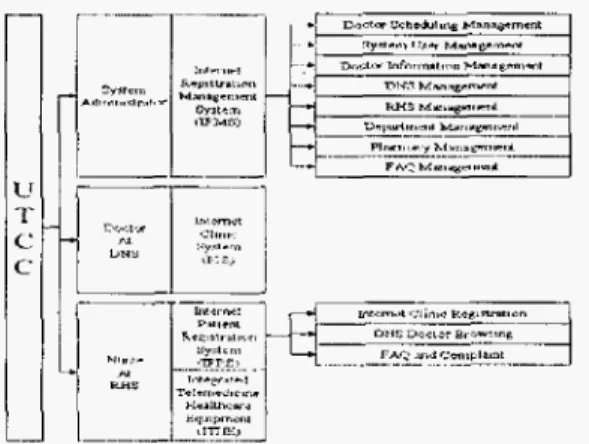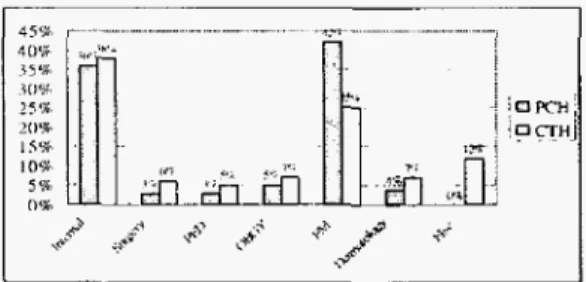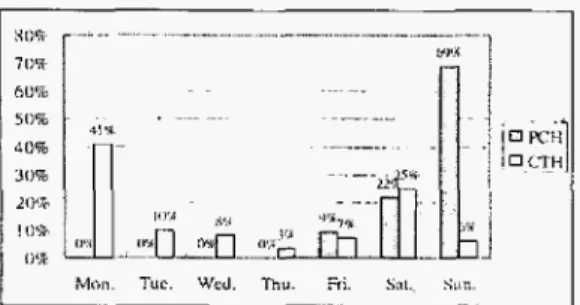Evaluation of the Low Cost Telemedicine System in Taiwan
J.J. Luh, P.H. Cheng*.+,
S.J.
Chen*, J.S. Lai', H.S. Chen** and H.C. C h u g t
School and Graduate Institute of Physical Therapy, College of Medicine,
National Taiwan University, Taipei, Taiwan
*
Graduate Institute of EIectronics Engineering and Department of Electrical Engineering,
National Taiwan University, Taipei, Taiwan
t
Department of Information Systems,
National Taiwan University Hospital and College of Medicine,
National Taiwan University, Taipei, Taiwan
SDepartment of Physical Medicine and Rehabilitation, College
of Medicine,
National Taiwan University, Taipei, Taiwan
**Departments
of Family Medicine and Medical Informatics,
National Taiwan University, Taipei, Taiwan
j
slai@ccms.
ntu.
edu
.tw
Abstract: A low cost telemedicine system which constructed with inexpensive, commercially available p a r t s and used ADSL network was developed for tele-consultation. This system enhanced the acceptability of the healthcare services for the mountainous region a n d redeem the lack of medicine man power in such area. T h e preliminary results from several medical centers a n d local hospita1 show t h a t this telemedicine system can meet the requirement of telemedicine uses.
Introduction
From 1992, the Cyber-Care Inc.'s Electronic Housecall (EHC) system could connect the blood pressure monitor, glucose monitor, digital thermometer, digital stethoscope, arterior oximeter, and weight scale. Currently, NTUH uses EHC-350 and Li-Shin tribe uses EHC-400. Both of them are connected with ISDN linesEl ][2][3]. We found some existing problems listed as follows:
In order to pursue the accuracy of clinic diagnosis, obviously, we have to invest a high budget on the related telemedicine equipments.
The system usage frequency is obviously very low. Instability of the cominunication quality implicitly hides behind the whole system.
The communication fee is so high that no one likes to invest on the system any more.
If the government stops the budget support, the routine telemedicine cannot be continued. The health insurance payment is not enough to cover the operating cost
It is very difficult to evaluate the ratio of the retum on investment.
Therefore, a IOW cost telemedicine should be designed to solve the problems mentioned above. I n
this study, we tried to design a telemedicine and evaluate its performance according by questionnaire. Materials and Methods
We cooperated with two national medical centers, .
two regional hospitals, and five remote native tribes (Fu-San, Li-Shin, Gin-Gun, Won-Fong, and Xai-Nun) which are all located inside Taiwan Central Mountain. This telemedicine. communicated with ISDN and Internet to the Intranet of NTUH. Inside NTUH, we allocated four points: the telemedicine clinic room at the Department o f Family Medicine, the discussion room at
6A inpatient building, the telemedicine room 405 and the teleeducation room 101 at the College o f Medicine. NTUH is also connected with Puli Christian Hospital (PCH) at mid-Taiwan. Meanwhile, another national hospital, National Cheng-Kung University Hospital
(NCKUH)
located at south Taiwan, is fully participating and connected with Cardinal Tien Hospital (CTH).To increase the service ratio and quality of the telemedicine, we propose the Union Telemedicine Clinics Center (UTCC) concept to achieve our goal. To show the power of telemedicine services, we choose five remote tribes listed as above, because all of them lack of healthcare resources.
We destgn, implement and setup an Integrated Telemedicine Healthcare Equipment (ITHE). The patients who live at the remote tribes are lack of healthcare resources except for the period of the regional Circular Healthcare (CH) services. Hence we train the nurse and volunteer how to use the ITHE system to immediately help the patients. The ITHE could be connected to doctor at the hospital site (DHS), with ADSL lines. Therefore, the UTCC and ITHE let most of the patients who live at remote tribes obtain the healthcare ,consulting services before they are transferred to the hospital. That is, the UTCC 0-7803-8940-9/05/$20.00 02005 IEEE. -
316
-compensates the vacancy of the routine regional CH services within such areas.
In accordance with the Communication Operating Model (COM) which announced by the DOH-Taiwan. each remote nursing station (RNS) should at least support 5 5 standing drugs, an electronic healthcare record (EHR) system, a fax machine, the prescription which is ordered by DHS. Then the trained and qualified nurses or volunteers at RNS could use the prescription to treat a specific patient,
In order to establish the telemedicine clinics at tribes, the UTCC could collect all of the resources of the telemedicine clinics at DHS. The processing flow uses network to connect RNS and DHS. The patient of a specific tribe could register his favorite clinic with the assist of internet or nurses at that tribe. Then the patient could till the basic personnel information and start diagnosis in a proper order. DHS will record the diagnosis at telemedicine EHR and write down the prescription. RNS will print out the current cfinical data, keep it in files, and follow up DHS orders to give
patient assigned medicine o r therapy. Figure 1 illustrates the EHR could diagnose and prescribe by DHS under the UTCC environment.
*e-- S .
1
Ia a "
Figure I : The EHR of UTCC
Table 1 : Comparison between ITHE and EHC
Items lTHE
EHC
Implementation Cost US$4,300 WS$8,500 Maintenance Cost
US$500
WS$3,500Communication Mode ADSL ISDN
Vital Sign Available Available
Glucose Available Available
SaO* Available Available
Body Temperature Available Available
Body Weight Available Available
Stethoscope Available Available
Expansibte Capability Easy No Available Another similar telephone operating interface is
TP
phone [13]. The advantages of this operating modelare easy installation, clear screen image, and clear voice quality. Meanwhile, we could connect externally to another larger screen and zoom idout the control
cainera lens. In fact, this model could act as a public education platform for health and nutrition or remote emergent communication equipment for the tribe people. The consultant contents could be the notations for diabetes, hypertension, etc.
The LJTCC includes four system modules: Internet Registration Management System
(IRMS),
Internet Patient Registration System (IPRS), internet Clinics System (ICs), and ITHE. Figure 2 illustrates the relatedhnctionalities of these four system modules.
Figure 2: The related functionslities of UTCC
In order to extend our UTCC with lower limitations, we use the HL7 [I41 standard to implement the data exchange interfaces inside our UTCC system.
Telemedicine doctors at
DHS
couId depend on his clinical specialty to divide the patient types Under the telemedicine referral duration, doctors could judge the field of the patient's condition through the screening by the nurses at RNS. Hence the doctors could concentrate the clinical appointment period and focus on the specific patient's condition to give them specific diagnoses That is, such healthcare behavior will let patient's diagnoses and cares gradually tit the patient's condition. Figure 3 illustrates the IPRS module of UTCC and we could easily biowse all of the doctors who serve from everyDHS through Internet
...
-
...
4.
U.-.
c.. .,!z-
,."Y #..I ,.-,,-
-L r----
- m w & m - d z - . w 2 0 p * r 0 0 "'F " . . ,_, .i . -317
-Figure 3: The IPRS module of
UTCC
Results
Many failures of telemedicine system are not from ,
technical failure. On the contrary, most of them are blindly catching up with the latest and advanced information technologies and burning their budgets. Actually, several medical referrals and consulting services could be completed with generic telephone, I n fact, many generic referrals methods among doctors are still running with such media.
An acceptable telemedicine is built on the weight between the cost and quality. We should realize our requirements and use the most feasible and effective solutions to
eam
the maximum fruitful results and minimum expenses. Examples of successful cases show that we could use~digital camera and e-mail to achieve the dermatology clinical referral, use fax machine to complete the judgment of remote electrocardiogram, use mail to filfill the remote radiology clinical referral of the X ray films [ 131. All of the above cases might already prove that it is feasible to use the low cost and reasonable information technology solutions to achieve telemedicine.Originally, the EHC-350 is used at home care
environment. Hence it emphasizes on its simplified usage for everybody. Nevertheless, it is doubtable whether it is necessary to use such highly expensive integrated home care system under the assistance of nurses or professionals at each RNS.
Moreover, we frequently emphasize on the on-line, live, and interactive conference hnctionality. Sometimes we might ignore much useful information. Practically, some information could use a stored and forward mechanism to refer from RNS to DHS at first. For example, we could
pass
the vital sign, glucose, and SaOz values which are gathered at RNS and send toDHS. Such operation only needs a simpfe teleconference system or a video phone to achieve the clinical referral. Based on the current quotations on the medical market, the total price o f a digital hemadynamometer, blood sugar meter, electronic stethoscope, and a teleconference system are under our acceptable budget. The above medical instruments could be operated easily by most RNS. This is a reasonable and feasible solution and doctor referral model is illustrated as follows.
Before the remote consulting process, RNS should
gather the vital sign, glucose, and S a 0 2 in advance and record data by hand, then fax or e-mail to DHS.
DHS can diagnose with data recorded by the telemedicine system.
DHS can advice and fax prescription to RNS. Discussion
Telemedicine had been implemented for a long time and the implementation technology gradually matured. Supported by the government, medical centers, and regional hospitals, the patient who lives at remote area could be served with similar metropolitan healthcare quality. This not only conquers the spatial and temporal unavailability, but also lets the medical resources be shared with mountain tribes.
Based on this project, both NTUH and NCKUH ally each other. Horizontally, we integrated with UTCC and NTUH designed the low cost
TTHE.
Through the cheap IP phone, we compensate the communication quality, promote the diagnosis quality, let doctor atDHS
get accurate symptom from remote patients.The church power inside the tribes help us to advise and educate the remote people, even act as a volunteer
and help the telemedicine operating. Obviously, church helps let people like to be diagnosis. with telemedicine system and increase the usage ratio of the telemedicine equipments.
However, the scheduling appointments between the patients and doctors at DHS could not'be easily made. The annual survey statistics from our five tribes, as shown in Tables 4 to 6, will illustrate such requirements from people who live at tribes. Both surveys have seven questions and we group into two categories, four tribes of PCH and one tribe of
CTH.
I I
Figure 4; Survey result of the most prefer clinic
Figure 5 : Survey result of the most prefer clinic time
I
1
Mon. TUC. Wcd. T h u . Fri. Sat. Skin.Figure 6: Survey result of the most prefer clinic day Hopehliy, UTCC could ally more medical centers and group more doctors to serve morc tribe people.
Since ITHE could gather several biomedical signals and let
DWS
diagnose in advance, ITHE implements a direct healthcare system which is necessary for tribe people. The1P
phone could promote the telemedicine services and act as a public education platform for CME and remote acute communication equipment. ConclusionsWe conclude this paper with some important and feasible points as follows.
ITHE integrates the telemedicine experience and EHR system ofNTUH to serve the hilly areas.
A UTTC is constructed to integrate the medical resources that can be shared by each hospital.
Low cost ITHE modules are designed and
deployed to tribes.
ITHE improves the unavailability of doctors in hilly tribes by the support of diverse clinics. ITHE remote education system promotes the quality of continuing medical education (CME). Performance and feasibility of the telemedicine system have been evaluated.
Acknowledgements
This research, "Mountain and island Telemedicine: NTUH Cross-domain Telemedicine Project for Aboriginal Area," is fully supported by the DOH- Taiwan and
NTUH.
References
[ I ] CHUNG-CHIH L., HENG-SWUEN C., CHING-YU C.,
AND SWENG-MOU H. (200 I ) : 'Implementation and
Evaluation of a Multimedia Telemedicine System in N T U " , Int? J. Med. Info., 6 , p p . I7S-182
[21 CHUNG-CHIH L., WEN-HAO H., JYH-HORNG C.,
HENG-SHUEN C . , CHING-YU C., AND SHENG-MOU H. (2000): 'A Middleware Architecture to Improve the Efficiency of Web-based Telemedicine Application'. Liiunled. Eny. App. Busis and Cummu., 20(3),pp.127-132
[3] CHUNG-CHIH L., JENG-REN D., CHIEN-TASI L.,
HENC-SHUEN C . , JENN-LUNG S., AND JYH-HORNG C. (1998): "An Unified Multimedia Database System to Support Telemedicine', IEEE Trims. Infur. Technal. BioMed.. 2(3), pp. 183-IY2
[4] WALTER H . H. (1974): 'Telemedicine: New
Application of Coinmunication Technology'. IEEE
Truns. Cuniniii , pp.685-688
R A L P I . ~ M. (1997): ' A n Architecture for Naval teleinedicine'. IEEE T u " . Injiw. Technol. BioMrd.,
161 FRANCESC'O P., MARCO M., AND GAERIELLA T. (2003): 'Thc Educational Offer in Medical Informatics and Telemedicine at Engineering Faculty
of
the Politecnico di Milano', IEEE Truns[5] WILLIAM 3 .
c.,
ROBERT 0 .R.,
JAMES M .c.,
AND1(1), pp.73-79
Ed&/., 4 6 ( 3 ) , ~ ~ . 3 Y 4 - 3 9 8
E71 M. HOWARD
w.,
GAVINv.,
GEORGEv.,
AND DAVID M. (2001): 'Developing a Regional Healthcare Information Network', IEEE Trans.hfur. Technal. BioMed., 5(2), pp.177-180
[8] EHSAN 0. S . A N D RAW S . (2002): 'ATMTN: A
Teleinommography Network Architecture', IEEE
Truns. BioMrd Eny., 49( IZ), pp- 1438- 1443 [9] PETER V., ZOLTAN B., AND BALAZS B. (2002): 'An
Open Architecture Patient Monitoring System Using Standard Technologies'. IEEE Tvuns. Injbr. Techno/. BiuMed., 6(1), pp.95-98
[ I O I M A R I N A K. (1997): Telemedicine: A Computer /
Communications Current and Future Challenge',
IEEE Potential, pp.29-3 I
(1999): 'Assessing Technological Barriers to Telemedicine'. IEEE Truns. Eng. Mgml., 46(3),
[12]DAVlD T. M., JONATHAN
s.,
AND WlLLliUlc.
R. (2000): 'Suilding an IP Network Quality-of-ServiceTested'. IEEE internet Comp., pp.65-73
[I3]ENRIQUE
J.
G . , FRANCISCOD.
P., EMILIOJ.
o.,
NORBERTO M . , AND HELLMER R. (1998): 'A
Broadband Multimedia Collaborative System for Advanced Teleradiology and Medical Imaging Diagnosis'. IEEE Truns. Info. Technol. BioMed.,
[ 141 HL7, Internet site address: http://www.hl7.org/ [ I I ] D A V I D L. P., KERI
E.
P.,
AND REUBENR.
M.
J.pp.279-288
2(3), pp.146-155


